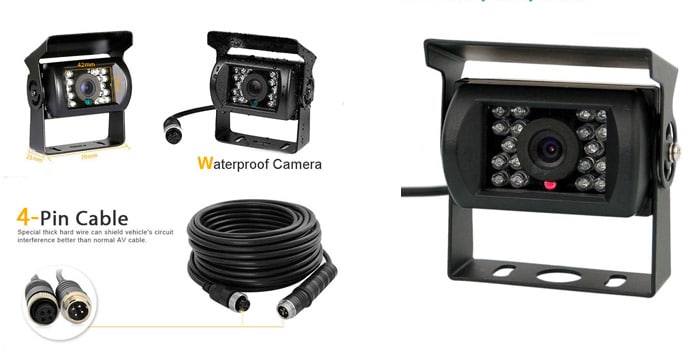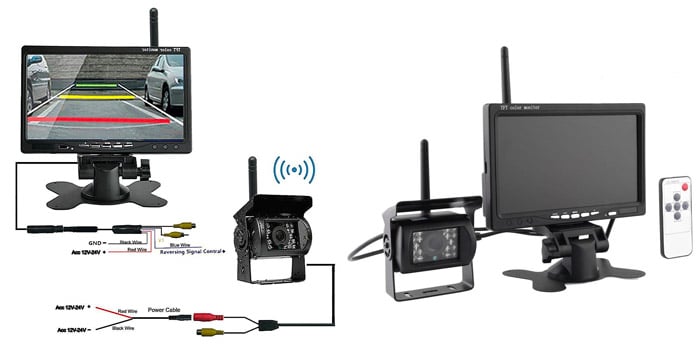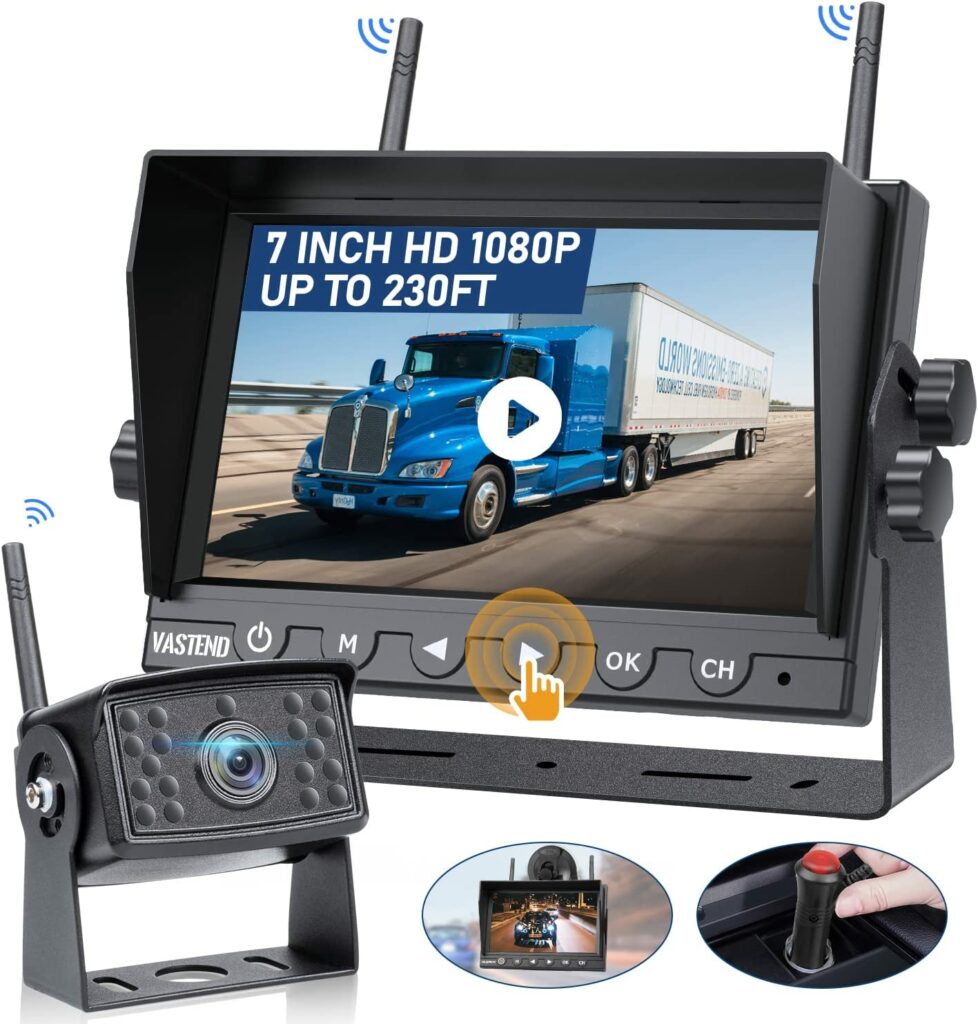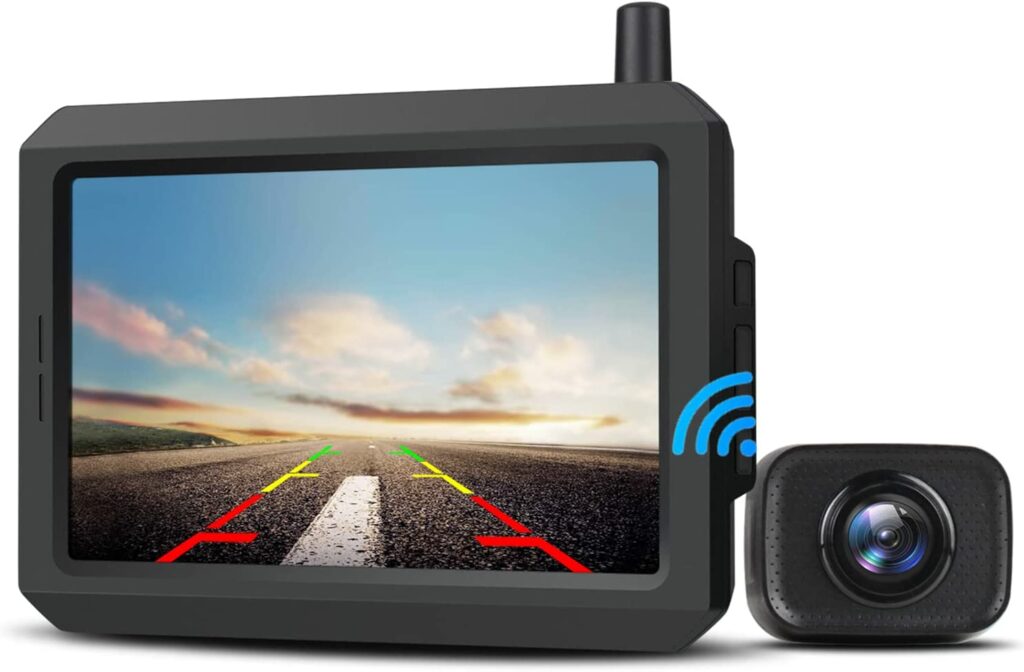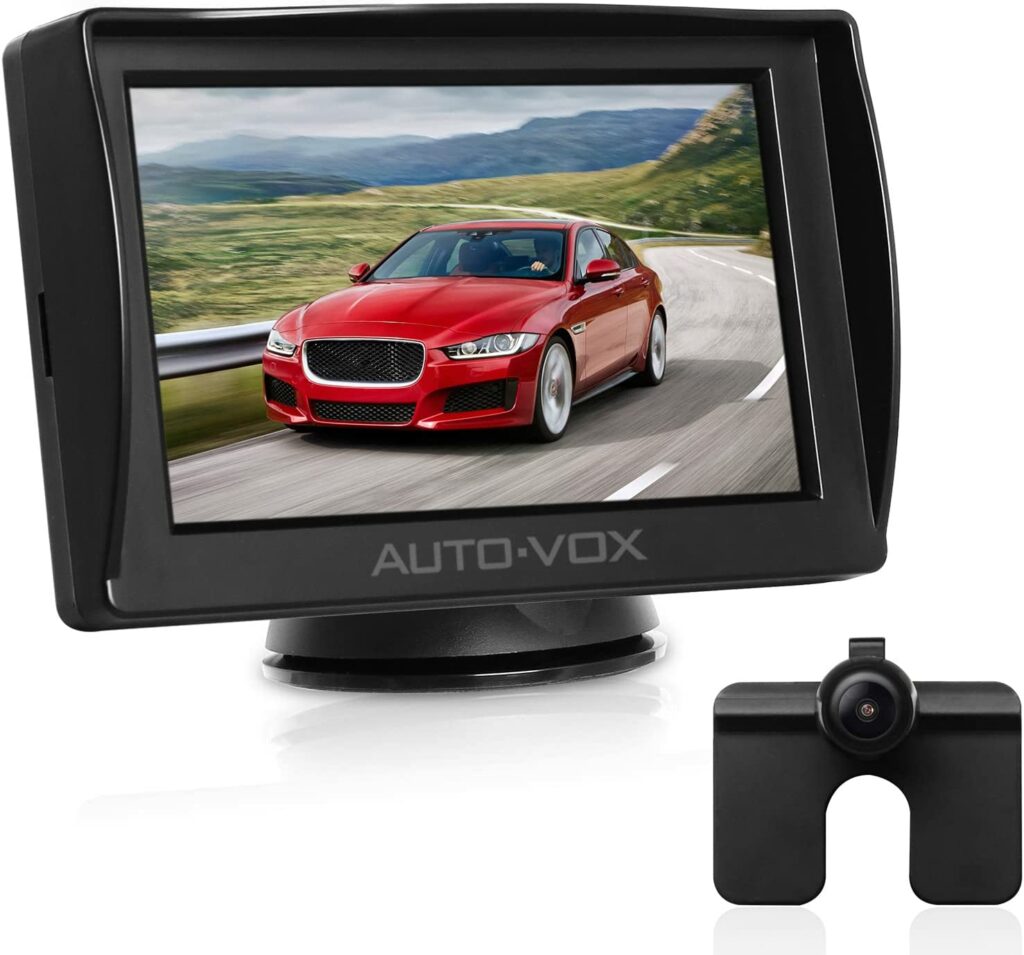Although systems are more sophisticated these days, driving with a caravan is still that little bit trickier than driving without one.
You may want to consider a reversing camera for your caravan or motorhome.
They are especially beneficial when it comes to driving in densely packed traffic. Any vehicles that are driving too close behind you would generally be invisible to your wing mirrors.
Table of Contents
Caravan Rear View Camera Kits (Our Recommendations)
There is quite a lot to choose from out there. Therefore, to help you we have put together some caravan rear view cameras that are worth checking out.
The first camera we want to draw your attention to is this excellent model from Camecho. The rear-view camera is waterproof with a rating of IP68. This means it is resistant to submersion of 30 minutes in a maximum depth of 1.5m of water and that it is also able to withstand sand, dirt and dust.
It consists of 18 infrared LEDS that offer a view reaching a distance of 20ft in night vision mode. The camera produces a wide-angle image of 120-degrees which can help to reduce and even eliminate blind spots and to avoid a collision when reversing.
It is a perfect, high performance, low-cost driving aid for novice towing drivers or just to give you that extra level of help. The wide range 12-24v DC power is compatible with most vehicles and it provides 24-hours of power. You can rotate the image that the camera captures vertically and horizontally and you are treated to high contrast and sharp picture.
Despite its low price, this will do the trick very nicely if you have a modest budget.
This next caravan rear view camera kit, from BW, features a wireless 7″ TFT LCD Monitor and a wireless 2.4GHz camera. While the 7″ TFT LCD monitor is powered by a DC 12 to 24v connection and features a video input with 2 channels that switch automatically, the wireless 2.4GHz camera offers wide viewing high definition angles and supports CMOS colour imaging and NTSC TV connections.
As you’d expect from something used on the outside of your touring vehicle, it has a good level of waterproofing. Although a more expensive model than the one above, it does offer a greater level of functionality and produces slightly better images.
Another wireless reversing camera that offers reasonable spec and high-quality enough imagery that makes it a worthwhile addition to your caravan outfit.
The camera is capable of capturing horizontal images of 170-degrees and vertical images of 120-degrees. It is compatible with NTSC, PAL and High Solution 420 televisions. It only comes into action when you begin reversing and helps you to avoid bumps and avoidable unnecessary collisions.
It’s another high-quality product at a low price.
Slightly more expensive again than others on this list, the Accfly features a DC 12v rear-view camera and a dc 12v 7″ TFT LCD monitor. Much like all the others on our list, you will find all the mounting equipment in the box with the camera and the monitor. Despite the price, you do get good value for money with a camera that is capable of capturing 120-degree wide vertical angles and 170-degree wide horizontal angles.
Your reversing and general manoeuvring will really benefit from the full colour and high-resolution display provided by the accompanying 7″ TFT LCD monitor.
Although the price is not always an indication of a good product, cheaper products can often be a let-down. It’s important to figure out which is the right one for you, regardless of your budget. We think this one offers enough in the way of features and easy to use functionality, to warrant careful consideration.
This wireless system is easy to set up, yet still quite pricey model is a great addition to your touring setup. It comes with the obligatory camera and monitor. As with all the models on this list, it features 18 IR LEDs designed to function well during the day and particularly at night.
So even when you are pulling up to the site and trying to reverse into your pitch, you will be able to without causing damage to your touring vehicle, tourer or anything else. The IR automatically switches into action when the darkness settles in and with 120-degree view field, it’s perfect for helping you manoeuvre efficiently, effectively and most importantly of all, safely.
While there is not a lot between the different models we’ve just discussed, we feel it’s up to you to decide which is right for you, based on your available budget, and the kind of setup you are looking for.
We are confident though, at Caravan Helper, that the rearview/reversing camera that will give you peace of mind while on the road and therefore, help you to enjoy your caravanning adventures more, is in among the cameras above.
Safer Lane Changes
Lane changes and overtaking, as any seasoned caravaner will agree, can be tricky to manoeuvre. The same can be said for when you must pull in after you’ve overtaken another vehicle.
Easier Reversing When Pitching or Hitching Up
Another way you can benefit from having a rear-view mirror or reversing mirror is when you are trying to fit into your pitching space or trying to hitch up once you arrive at a site. With a parking camera, you don’t need to solely rely on a member of your travelling party bellowing directions.
When you consider the fact that so many of the insurance claims made by caravanners tend to be related to damages caused while reversing, investing in a camera is a good idea.
Things to Consider When Looking at Reversing and Rear-View Cameras
As is the case with any caravan accessories really, wireless rearview cameras come in a variety of different prices and include various functions and features. As alluring and enticing as the top-range, everything-included-but-the-kitchen sink model may appear or as cost-effective as the budget one may seem, you need to consider what you really need from your caravan camera. It doesn’t make sense to pay out for an expensive camera for a bunch of features you aren’t going to use often.
Some important features that may interest you when buying a reversing camera system:
- Wired systems or Wireless? While wireless camera systems are much easier to fit without seeking professional help, there may be issues with drops in the signal. On the other hand, wired camera systems tend to be expensive and require a professional installation, which adds more to the overall cost. The major benefit is though that it is more reliable.
- Screen size: Most camera system screens for caravan reversing or rearview tend to measure between the 3 and 7 inches mark. Perhaps you want a slightly bigger screen…you’d need to investigate what size would safely fit on the dash or windscreen of your towing vehicle.
- One Camera or Two? There are some camera systems out there that utilise two cameras – one on the towing car to help when you are hitching and the other on the caravan. Think about your budget and what you’d prefer.
- Night Vision: Although this might sound like a ridiculous feature at first glance. If you’re likely to be pitching up early in the morning or late at night, or reversing back into your storage facility at a similar time, it can be a very practical feature.
Once you have worked out the features you need for your caravan camera system, don’t just rush out and buy the first one that ticks all the boxes. Take some time to read through several online customer reviews. These not only indicate whether it’s wise to buy a camera or not but could also provide helpful hints and suggestions for getting the best use out of it. Caravan forums and discussion groups are also worth looking at, along with consumer watchdog and review sites like Which? etc.
What Are the Downsides?
You got to consider the bad with the good when buying technology and although there are numerous benefits, as we’ve discussed already, there are also several downsides to caravan cameras. Some people think, for example, that caravanners that rely on cameras for reversing and other manoeuvres become over-confident and lazy when it comes to basic driving techniques.
Reversing Cameras Are Not a Replacement for Your Driving Skills
Reversing and rear-view cameras should only be used to enhance and improve the skills you already have as a driver, not replace them. The key factor that comes into play and often is the cause of accidents, is not paying proper attention.
Cameras Can Give You a False Sense of Security
Many objectors feel that reversing and rear-view cameras give caravanners a false sense of security. When they have a camera system, they might start forgetting to check blind spots and rely on the camera too much. Following nicely from the above though, if you’re going to have a camera then, you need to be sure you still follow the basic procedures.
They Are Not 100% Reliable
It’s worth remembering, that even if you have a good camera system, they are not completely reliable. there have been situations in the past where cameras and other forms of driving assistance have been responsible for accidents. This is normally down to the driver relying solely on the technology and it failing to pick up on a pole or lamppost that the driver didn’t check for with his eyes.
All Driving Assistance Technology Is Only as Good as The Driver Using It
It doesn’t matter how good it is or how sophisticated it is, you need to make sure you read the instructions properly before using a reversing or rear-view camera. You also need to test it out properly before hitting the road with it.
Top Tips
To further aid your buying decisions, we have put together some tips for you to follow that will ensure you don’t waste your money.
- The type of sensor on the camera can affect how well a reversing camera will work. CMOS or Complementary Metal-Oxide Semiconductor sensors are the cheapest on the market and what you will normally find in cheaper cameras. These can be compromised by sunlight and don’t work very well at night, but are perfect if you just need a cost-effective camera for more basic uses. CCD or Charge-Coupled Device sensors, on the other hand, are much more sophisticated, provide better imagery but are as much as double the price. Ideally though, if you’re investing in a multi-purpose camera system, this is the type of sensor you need to look for.
- Always check that the camera has the same connectors that are compatible with your caravan. If it doesn’t, you can buy adaptors, but it’s better to know this information before you invest in a camera system.
- If you are in any way unsure about the installation, seek professional help from a fully qualified electrician. Even if the system is a relatively simple one, even minor mistakes can cause serious problems. Confusing the positive and negative connectors, for example, could cause your brand-new camera system to blow-out before you even use it.
- The best viewing angles for reversing cameras and rear-view cameras is around 50 to 70 degrees. While there are some manufacturers that claim their systems are capable of more, anything above 120 degrees is probably going to be distorted.
- Always remove systems before you wash your vehicle. They are waterproof, but it’s not worth risking it. You should also be careful not to get any cleaning solutions or wax on the lens either.
- Repair any damages your camera suffers from debris, stones or salt off the road, particularly during wintertime. Don’t delay in doing this, because most minor repairs are easy to do. If you leave the problem to get worse, you may have to completely replace your system.
Understanding the Law and Reversing and Rear-View Cameras
The standard driving laws apply to you whether you are using a camera system or not, but you should note the following:
It is legally acceptable to have a camera operational when you are driving, even if it’s a reversing system if you are wanting to monitor vehicles behind you. However, it’s worth noting that unless it is positioned in the best place, this unlikely to be beneficial. Most risks come from vehicles to the side of either your caravan or towing vehicle.
Having reverse cameras does not mean you can skip investing in towing mirrors.
Even with cameras:
- You still need to have towing mirrors if the trailer or caravan is wider than the car you are using to tow it.
- You legally need to have a clear vision of at least 4 metres to the side and 20 metres behind the driver
- Failing to adhere to these rules, if you are caught, will land you with 3 points on your driving licence and a fine costing a maximum of £1,000 for every mirror-related infringement.
Some other towing accessories you might need:
- A caravan towing cover to keep the front of your caravan clean and bug-free.
- Check the weight of your caravan nose with a weight gauge before you leave the house to tow
- Should you invest in a stabiliser when towing your caravan?
